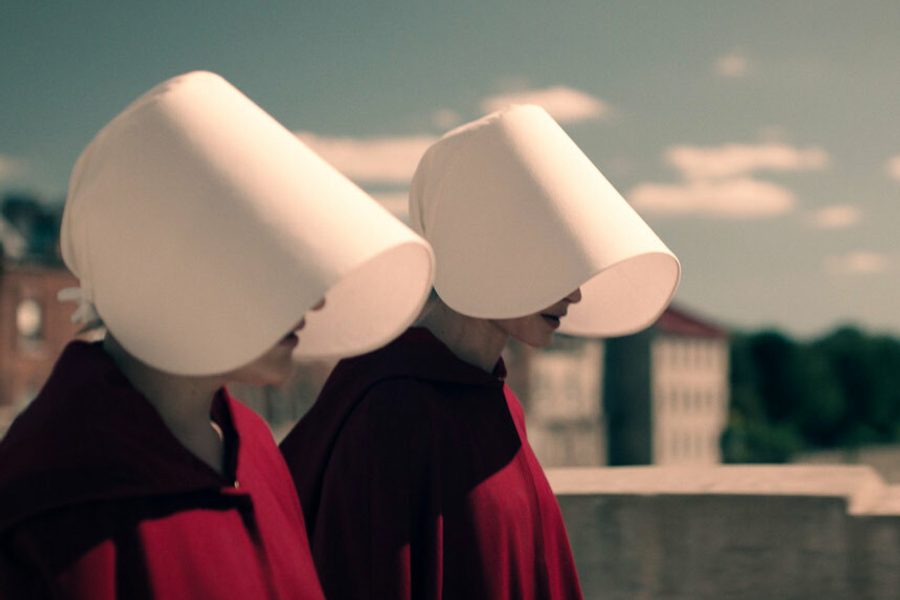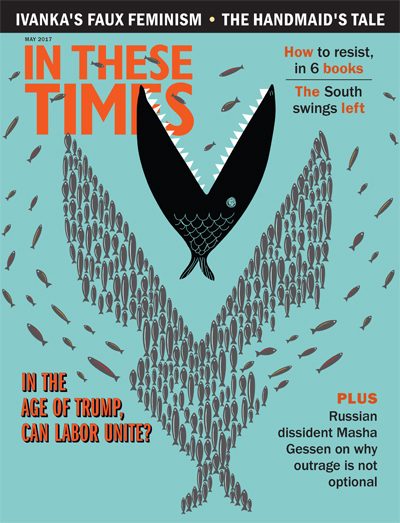Hulu’s Brilliant Adaptation of “The Handmaid’s Tale” Says More About Our Present Than Our Future
For many marginalized women, dystopia is already here.
Jessica Stites

This February, 32 years after its publication, Margaret Atwood’s The Handmaid’s Tale became Amazon’s number one bestseller. The feminist dystopia imagines a government takeover by misogynist authoritarians, and the book’s sales were propelled by the fear that its fiction was merging into reality.
Yet three months under Trump, we don’t live in The Handmaid’s Tale: no secret police; no hijacked bank accounts; no reeducation camps. As many have observed, such totalitarian tales feel less relevant to 21st-century America than consumerist dystopias, like Brave New World or CivilWarLand in Bad Decline. Why should a corporate capitalist state bother with repression when the distractions of cheap goods and good TV render the public compliant and complicit?
Then again, our autocrat-in-chief has a penchant for less subtle means of control, and works like Atwood’s remain calls for vigilance. She says she wrote the book as an antiprediction: “If this future can be described in detail, maybe it won’t happen.”
The draw of that “maybe” will lead many to tune in to an eerily well-timed television adaptation coming to Hulu in late April. Like the book, the 10-part series is chilling, riveting, designed to sear itself into our brains. Tight shots place us claustrophobically in the world of the “handmaid,” June, who has been thrust into reproductive slavery, forced to bear a child for one of the coup’s commanders. As June, Mad Men’s Elisabeth Moss uses eloquent microexpressions to convey the fatigued adrenaline of captivity. Even rape is simultaneously terrifying and boring, as she stares at the ceiling and, in an internal monologue, riffs on the color blue (“Blue Moon,” “Tangled Up in Blue”).
How did we get here? As the back story emerges, we learn that, like all sea changes, it seemed to happen overnight, yet clues were there. “I was asleep before,” June reflects. “When they slaughtered Congress. When they blamed ISIS. We didn’t wake up then either. They said it would be temporary. Nothing changes instantaneously. … In a gradually heating bathtub, you’d be boiled to death before you know it.” On the day it comes to boil — when women’s bank accounts are frozen, their employment terminated, their assets transferred to their nearest male kin — June and her best friend, Moira (Samira Wiley) join a band of ragtag protesters waving handmade signs. It’s a scene that could have been ripped straight from January 21 — except that the police open fire, jolting Moira and June awake to the new reality, too late. Therein lies a warning: Are our civil rights more precarious than we realize?
But to read The Handmaid’s Tale as simply a cautionary tale about a totalitarian future is to miss its rich resonances. It is a story about the past, and the present. Atwood describes the writing of the book as bricolage, an assemblage pulled together from material she had available to her: her own trips behind the Iron Curtain, accounts of slavery and cults, and other documentation of myriad ways that states have regulated their citizens and patriarchies have controlled women’s bodies.
For those who watch in fear that Trump may one day come for them, the takeaway of this series will be its resonance with the ways people are already disempowered. For some, America is already a police state. When a dark van full of secret police, known as “Eyes,” pulls up beside June, we cringe with her as she schools herself to keep walking, to act normal, it’s hard not to see the parallel to (and the pun on) ICE. The shots of police opening fire on protesters echo the footage of police training hoses and rubber bullets on Standing Rock water protectors. Perhaps most uncanny is how the opening scene of June fleeing for the Canadian border, alternately carrying and dragging her young daughter through the woods, mirrors the news footage of Sudanese refugees fleeing to Canada to escape Trump’s ban, tossing children and baggage over an imaginary line in the brush.
The Handmaid’s Tale offers no smiling Mountie to scoop up June’s daughter. She is ripped away, and June’s desperation to reclaim her drives the rest of the show. That quest makes visceral the lived reality of many who rarely find their way into newscasts: the children and parents separated by war, by a welfare system that punishes the poor, by the imperatives of global capitalism, and by refugee and immigration policy.
Translating these overlooked injustices into TV drama — and putting a famous white woman in the starring role — is a seditious way to smuggle them into our living rooms. The immediacy of June’s story punctures our numbness, our compassion fatigue and the feeling of being overwhelmed by intractable forces. For too long we have accepted things as they are. The Handmaid’s Tale wakes us to the strangeness of reality.
At a re-education center for June and the other new “handmaids,” a Miss Trunchbull-esque instructor coos, “I know this must feel strange. But ordinary is just what you are used to. This may not seem ordinary to you right now, but after a time it will.” June struggles to hold on to her sense of what’s normal and right. And through that struggle, The Handmaid’s Tale demands an answer: What have we let become ordinary, and how can we render it not?
Jessica Stites is Editor-at-large for In These Times.









